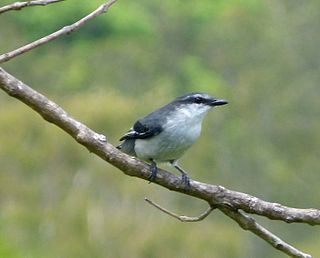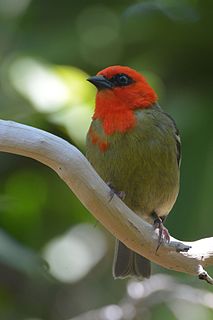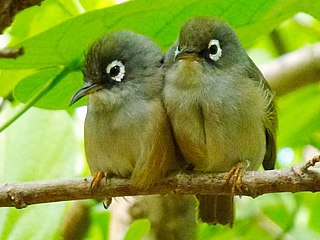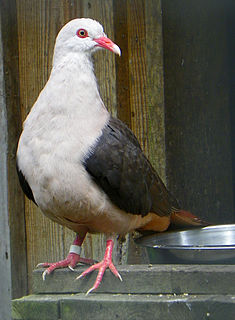 W
WThe broad-billed parrot or raven parrot is a large extinct parrot in the family Psittaculidae. It was endemic to the Mascarene island of Mauritius in the Indian Ocean east of Madagascar. It is unclear what other species it is most closely related to, but it has been classified as a member of the tribe Psittaculini, along with other Mascarene parrots. It had similarities with the Rodrigues parrot, and may have been closely related.
 W
WCheke's wood rail, also known as Sauzier's wood rail, is an extinct species of rail which was endemic to the Mascarene island of Mauritius. It was described by British ornithologist Julian P. Hume in 2019, and the name honours British ecologist Anthony S. Cheke.
 W
WThe dodo is an extinct flightless bird that was endemic to the island of Mauritius, east of Madagascar in the Indian Ocean. The dodo's closest genetic relative was the also-extinct Rodrigues solitaire, the two forming the subfamily Raphinae of the family of pigeons and doves. The closest living relative of the dodo is the Nicobar pigeon. A white dodo was once thought to have existed on the nearby island of Réunion, but this is now thought to have been confusion based on the also-extinct Réunion ibis and paintings of white dodos.
 W
WThe echo parakeet is a species of parrot endemic to the Mascarene Islands of Mauritius and formerly Réunion. It is the only living native parrot of the Mascarene Islands; all others have become extinct due to human activity. Two subspecies have been recognised, the extinct Réunion parakeet and the living echo parakeet, sometimes known as the Mauritius parakeet. The relationship between the two populations was historically unclear, but a 2015 DNA study determined them to be subspecies of the same species by comparing the DNA of echo parakeets with a single skin thought to be from a Réunion parakeet. As it was named first, the binomial name of the Réunion parakeet is used for the species; the Réunion subspecies thereby became P. eques eques, while the Mauritius subspecies became P. eques echo. Their closest relative was the extinct Newton's parakeet of Rodrigues, and the three are grouped among the subspecies of the rose-ringed parakeet of Asia and Africa.
 W
WThe red fody, also known as the Madagascar fody in Madagascar, red cardinal fody in Mauritius, or common fody, is a small bird native to Madagascar and introduced to various other islands in the Indian Ocean. It is a common bird within its restricted range, and the International Union for Conservation of Nature has assessed its conservation status as being of "least concern".
 W
WThe Rodrigues fody is a rare species of bird in the weaver family. It is endemic to Rodrigues, an island of Mauritius. It is classified by BirdLife International as being vulnerable. It is also on the United States' Endangered Species List with an endangered status.
 W
WThe Mascarene grey parakeet or Thirioux's grey parrot, is an extinct species of parrot which was endemic to the Mascarene Islands of Mauritius and Réunion in the western Indian Ocean. It has been classified as a member of the tribe Psittaculini, along with other parrots from the Islands.
 W
WThe Mascarene paradise flycatcher is a species of bird in the monarch-flycatcher family Monarchidae. It is endemic to the Mascarene islands of Mauritius and Réunion. There are two subspecies recognized: the nominate subspecies from Réunion, also known as the Réunion paradise flycatcher; and T. b. desolata from Mauritius. The Mascarene paradise flycatcher was originally described in the genus Muscicapa and the subspecies T. b. desolata was originally described as a separate species.
 W
WThe Mascarene swiftlet is a species of swift in the family Apodidae. It is found in Mauritius and Réunion, and the populations on the two islands have recently been confirmed to differ subspecifically. The nominate race francicus is found on Mauritius and the recently described race saffordi occurs on Réunion. Its natural habitats are subtropical or tropical moist lowland forest, subtropical or tropical high-altitude shrubland, subtropical or tropical high-altitude grassland, caves, arable land, and heavily degraded former forest. It is threatened by habitat loss.
 W
WThe Mascarene teal, also known as Sauzier's teal and Mauritian duck, is an extinct dabbling duck that formerly occurred on the islands of Mauritius and Réunion. It was a small teal of the Anas gibberifrons superspecies of the Anas subgenus Nettion. Its closest relative is probably Bernier's teal from Madagascar and, apart from having stronger wings and being considerably bigger, it seems to have looked very similar to that species. Earlier, it was proposed that Meller's duck, also from Madagascar, is the closest living relative of A. theodori, but as more remains of the latter were unearthed this appears far less likely. Apart from a few, brief descriptions, not much is known about the bird in life, but its habits probably did not differ significantly from those of its close relatives. Bones have been found in the Mare aux Songes swamp on Mauritius and more recently on Réunion also. The scientific name honours Thé́odore Sauzier, who made many bones of extinct birds found on Mauritius available to science.
 W
WThe Mauritian wood pigeon is an extinct species of the pigeon genus Columba which was endemic to Mauritius. The holotype is a right tarsometatarsus collected in 1910 by Etienne Thirioux.
 W
WThe Mauritius bulbul, is a songbird belonging to the bulbul family, Pycnonotidae. It is endemic to Mauritius.
 W
WThe Mauritius cuckooshrike is a species of bird in the family Campephagidae. It is endemic to Mauritius.
 W
WThe Mauritius fody is a rare species of bird in the weaver family. It is endemic to the island of Mauritius. It is classified by BirdLife International as being endangered. It is also on the United States' Endangered Species List with an endangered status.
 W
WThe Mauritius grey white-eye is a species of bird in the family Zosteropidae. It is endemic to Mauritius. It inhabits woodlands, forests, and gardens. The Réunion grey white-eye is very closely related. They were formerly considered conspecific and together called Mascarene white-eye.
 W
WThe Mauritius kestrel is a bird of prey from the family Falconidae endemic to the forests of Mauritius, where it is restricted to the southwestern plateau's forests, cliffs, and ravines. It is the most distinct of the Indian Ocean kestrels. It colonized its island home to evolve into a distinct species probably during the Gelasian . It is the most distant living species among the western Indian Ocean kestrels.
 W
WThe Mauritius night heron is an extinct night heron species from Mauritius. It is only known by seven subfossil bone remains consisted of cranium, pelvis, coracoid, ulna, radius, and tarsometatarsus found in Mare aux Songes. Only the coracoid and the tarsometatarsus are left today. It was scientifically discussed in 1893 by Alfred Newton and Hans Gadow from the Cambridge University. Newton and Gadow measured the tarsometatarsus with 81 to 87 mm. It became presumedly extinct in the late 17th century and was probably first mentioned by François Leguat in 1693 who described them as a "great flight of bitterns".
 W
WThe Mauritius olive white-eye is a very rare passerine from the family of white-eyes (Zosteropidae). It is endemic to the island of Mauritius.
 W
WThe extinct Mauritius owl, also known as Mauritius scops owl, Mauritius lizard owl, Commerson's owl, Sauzier's owl, or Newton's owl, was endemic to the Mascarene island of Mauritius. It is known from a collection of subfossil bones from the Mare aux Songes swamp, a detailed sketch made by de Jossigny in 1770, a no less detailed description by Desjardins of a bird shot in 1836, and a number of brief reports about owls, the first being those of Van Westzanen in 1602 and Matelief in 1606.
 W
WThe Mauritius sheldgoose, also known as the Mauritius shelduck, is an extinct species of goose from Mauritius.
 W
WThe Mauritius starling is an extinct species of starling, described in 2014 by Julian P. Hume, based on subfossils from Mauritius. The holotype mandible was discovered in 1904, but was hidden in a museum drawer for over a hundred years, hence the genus name. The Mauritius starling was shown to be closer to the Rodrigues starling than to the hoopoe starling of Réunion.
 W
WThe lesser noddy, also known as the sooty noddy, is a seabird in the family Laridae. It is found near the coastlines of Comoros, Kenya, India, Maldives, Mauritius, Seychelles, Sri Lanka and United Arab Emirates.
 W
WBarau's petrel is a medium-sized gadfly petrel from the family Procellariidae. Its main breeding site is the island of Réunion in the Indian Ocean.
 W
WThe pink pigeon is a species of pigeon in the family Columbidae endemic to Mauritius. The pink pigeon nearly became extinct in the 1990s and is still very rare. It is the only Mascarene pigeon that has not gone extinct. It was on the brink of extinction in 1991 when only 10 individuals remained, but its numbers have increased due to the efforts of the Durrell Wildlife Conservation Trust since 1977. While the population remains at below 500 birds as of 2011, the IUCN downlisted the species from Critically endangered to Endangered on the IUCN Red List in 2000, and then downlisted it again to Vulnerable in 2018.
 W
WThe Réunion harrier or Réunion marsh harrier is a bird of prey belonging to the marsh harrier group of harriers. It is now found only on the Indian Ocean island of Réunion, although fossil material from Mauritius has been referred to this species. It is known locally as the papangue or pied jaune. The Malagasy harrier of Madagascar and the Comoro Islands was previously treated as a subspecies of this bird but is increasingly regarded as a separate species. The Réunion harrier appears to be declining in numbers and it is classed as an endangered species.
 W
WThe Rodrigues starling is an extinct species of starling that was endemic to the Mascarene island of Rodrigues. Its closest relatives were the Mauritius starling and the hoopoe starling from nearby islands; all three are extinct and appear to be of Southeast Asian origin. The bird was only reported by French sailor Julien Tafforet, who was marooned on the island from 1725 to 1726. Tafforet observed it on the offshore islet of Île Gombrani. Subfossil remains found on the mainland were described in 1879, and were suggested to belong to the bird mentioned by Tafforet. There was much confusion about the bird and its taxonomic relations throughout the 20th century.
 W
WThe Rodrigues warbler is a species of Old World warbler in the family Acrocephalidae.
 W
WThe red-tailed tropicbird is a seabird native to tropical parts of the Indian and Pacific Oceans. One of three closely related species of tropicbird (Phaethontidae), it was described by Pieter Boddaert in 1783. Superficially resembling a tern in appearance, it has almost all-white plumage with a black mask and a red bill. The sexes have similar plumage. As referenced in the common name, adults have red tail streamers that are about twice their body length. Four subspecies are recognised, but there is evidence of clinal variation in body size—with smaller birds in the north and larger in the south—and hence no grounds for subspecies.